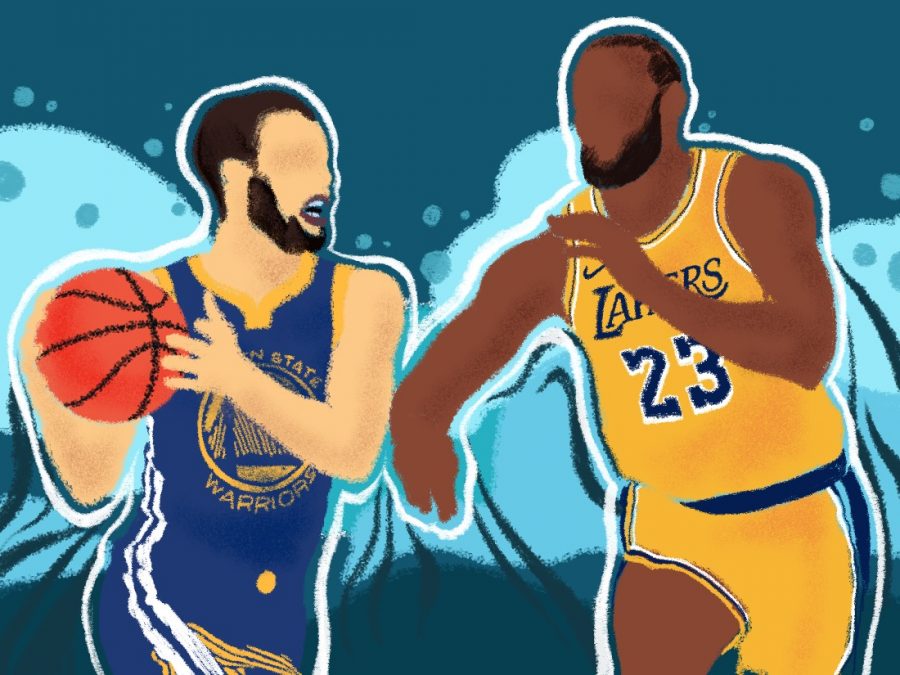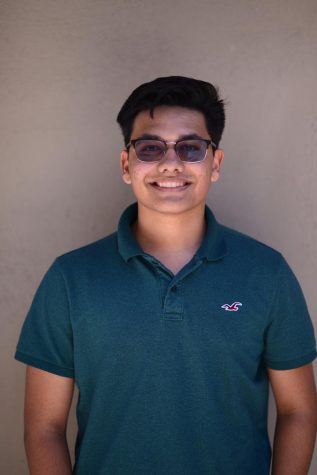Going pro: From high school to the big leagues
Both paths yield entirely different benefits –– the path to the big leagues brings potential fame and glory, while the academic path hauls in a steadier lifestyle. So perhaps Shakespeare had it wrong, after all. To sport or not to sport –– now, that is the real question.
March 19, 2020
In the world of sports, it is fair to say that an athlete’s journey to the professional leagues, more often than not, begins in high school. This is how it’s been for years—since back when Stephen Curry graduated from Charlotte Christian High School in 2006 and even further back, when Lebron James attended Saint Vincent-Saint Mary High School in 2003.
In 2006, long before he added the six time All-Star, three time National Basketball Association (NBA) champion and two time Most Valuable Player (MVP) award recipient to his list of accolades, Curry was, put mildly, a high school standout at Charlotte Christian High. Throughout his high school basketball career, Curry led his team to three conference titles and three state playoff appearances and as a result, was named all-conference, all-state and team MVP.
Needless to say, with such stunning accomplishments already under his belt, Steph should have been a highly sought after high school recruit. However, he ended up receiving not much interest from the major college basketball programs. As a result, Steph decided on signing with Davidson College, where he would spend the next three years training often, learning to become more confident in his ability to score baskets, and further honing in on his craft before declaring for the NBA 2009 draft.
James, on the other hand, shared an equally successful high school career: he led his team to two straight Division III state titles in his freshman and sophomore year at St. Vincent-St. Mary High. In fact, in his sophomore year, James was selected for USA Today’s All-USA Team, a highly prestigious award for high school athletes, as well as in his junior year for several other notable awards. Lebron continued his high caliber level of playing into his senior year, where he led his school to a third Division III state title.
Finally, after graduating high school, Lebron James was able to immediately declare for the NBA draft in 2003. But three years later, in 2006, a new rule was implemented by the NBA: the “one and done” rule. This was one of the biggest differences made between James’ 2003 and Curry’s 2009 draft. The “one and done” rule mandates that players must spend at least one year in college before declaring for the NBA. As a result, though James was able to declare for the 2003 NBA draft fresh out of high school, Curry was required to spend at least a year in college before declaring for an NBA draft.
This rule is one that has been met with much controversy in the past, and the current NBA commissioner, Adam Silver, has even spoken on the possibility of it being abolished, according to ESPN. On one hand, the pros of having the “one and done” rule in effect include allowing teams an extra year to scout the player before deciding on whether to draft them or not. With this extra year of evaluation, the player is able to mature more, and the team can observe whether the player will be able to continue performing at the same level for years to come rather than just turning out to be a bust the following year.
There’s yet another positive that is gained from the rule, which according to ESPN, Silver himself has spoken of in the past: “going to these great college programs is the better path to the NBA.” Players should also spend time at college to educate themselves as well in case that something tragic, such as a career-ending injury, goes awry on the path to the professional leagues.
Meanwhile, two of the biggest cons of the rule is that these draft prospects may decide on joining a different league instead of the NBA and join one overseas, such as LaMelo Ball plans to do in Lithuania. As a result, the NBA would lose out on significant talent additions from this rule. Another con is that players lose the opportunity to earn money straight out of high school. In extreme cases, they would be forced to wait another year to earn money to support their families, and the players lose one of their prime years in the sport.
But a player’s commitment to their sport runs deeper than just putting their bodies on the line under risk of an injury—a player is also required to make a huge investment, both physically and emotionally. And here, at Harker, it’s no different.
Harker athletes must devote hours practicing on the field and on the court after school to prepare themselves for upcoming games. As a result, athletes’ bodies experience a certain degree of fatigue everyday which can come in the form of muscle soreness and even in some cases a serious injury which can set back the athlete’s progress in their season.
Moreover, this devotion to improving themselves everyday also can be said to hinder their academic pursuits. Because of the large time investment, Harker athletes will either be forced to stay up later at night to finish homework and studying, which leads to fewer hours of sleep. And, as most of us as high schoolers know, fewer hours of sleep correlates to a weaker academic performance and also a decline in athletic progress too.
Despite this, there are many benefits to an athlete when they fully commit themselves to their sport. First, by committing to a sport, athletes are one hundred percent motivated to give it their all, whether that means practicing several hours everyday or sacrificing other commitments. This means that the athlete is able to constantly maintain and develop their skills to a higher level of mastery, which enables them to draw the attention of college athletics recruiters.
With the help of these recruiters, athletes can receive sizable sports scholarships to Division 1 schools which obtain a great bulk of attention from the professional leagues, thus serving as a launchpad for the schools’ athletes into each respective sports’ drafts.
Meanwhile, a separate course would involve less of a commitment from an athlete to their sport, with a greater emphasis being placed onto the student’s academics at school, where they can soak in the knowledge and bear the fruits of a well-focused academic career.
Of course, at the end of the day, the decision to be made rests on the student-athlete’s shoulders because ultimately, the choice is theirs. Both paths yield entirely different benefits—the path to the big leagues brings potential fame and glory, while the academic path hauls in a steadier lifestyle. So perhaps Shakespeare had it wrong, after all. To sport or not to sport—now, that is the real question.
An athlete’s investment and commitment to their sport should be recognized as no small thing, but clearly, there are downsides to an athlete prioritizing their sport completely over their academic endeavors in school since the possibility of a devastating, career-ending injury always remains.


















![“[Building nerf blasters] became this outlet of creativity for me that hasn't been matched by anything else. The process [of] making a build complete to your desire is such a painstakingly difficult process, but I've had to learn from [the skills needed from] soldering to proper painting. There's so many different options for everything, if you think about it, it exists. The best part is [that] if it doesn't exist, you can build it yourself," Ishaan Parate said.](https://harkeraquila.com/wp-content/uploads/2022/08/DSC_8149-900x604.jpg)




![“When I came into high school, I was ready to be a follower. But DECA was a game changer for me. It helped me overcome my fear of public speaking, and it's played such a major role in who I've become today. To be able to successfully lead a chapter of 150 students, an officer team and be one of the upperclassmen I once really admired is something I'm [really] proud of,” Anvitha Tummala ('21) said.](https://harkeraquila.com/wp-content/uploads/2021/07/Screen-Shot-2021-07-25-at-9.50.05-AM-900x594.png)







![“I think getting up in the morning and having a sense of purpose [is exciting]. I think without a certain amount of drive, life is kind of obsolete and mundane, and I think having that every single day is what makes each day unique and kind of makes life exciting,” Neymika Jain (12) said.](https://harkeraquila.com/wp-content/uploads/2017/06/Screen-Shot-2017-06-03-at-4.54.16-PM.png)








![“My slogan is ‘slow feet, don’t eat, and I’m hungry.’ You need to run fast to get where you are–you aren't going to get those championships if you aren't fast,” Angel Cervantes (12) said. “I want to do well in school on my tests and in track and win championships for my team. I live by that, [and] I can do that anywhere: in the classroom or on the field.”](https://harkeraquila.com/wp-content/uploads/2018/06/DSC5146-900x601.jpg)
![“[Volleyball has] taught me how to fall correctly, and another thing it taught is that you don’t have to be the best at something to be good at it. If you just hit the ball in a smart way, then it still scores points and you’re good at it. You could be a background player and still make a much bigger impact on the team than you would think,” Anya Gert (’20) said.](https://harkeraquila.com/wp-content/uploads/2020/06/AnnaGert_JinTuan_HoHPhotoEdited-600x900.jpeg)

![“I'm not nearly there yet, but [my confidence has] definitely been getting better since I was pretty shy and timid coming into Harker my freshman year. I know that there's a lot of people that are really confident in what they do, and I really admire them. Everyone's so driven and that has really pushed me to kind of try to find my own place in high school and be more confident,” Alyssa Huang (’20) said.](https://harkeraquila.com/wp-content/uploads/2020/06/AlyssaHuang_EmilyChen_HoHPhoto-900x749.jpeg)








